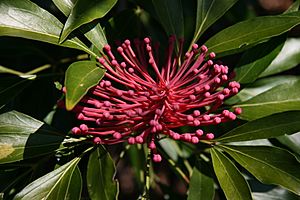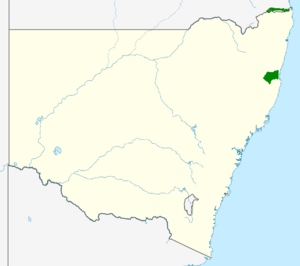Alloxylon pinnatum facts for kids
Quick facts for kids Alloxylon pinnatum |
|
|---|---|
 |
|
| Scientific classification | |
| Genus: |
Alloxylon
|
| Species: |
pinnatum
|
 |
|
| Range of A. pinnatum in northern New South Wales and southeastern Queensland | |
| Synonyms | |
|
|
The Alloxylon pinnatum, also called the Dorrigo waratah, is a beautiful tree. It belongs to the Proteaceae plant family. You can find it growing in warm, wet rainforests in south-east Queensland and northern New South Wales, Australia.
This tree has shiny green leaves. Some leaves are deeply lobed, like a feather (called pinnate), and can be up to 30 cm (12 in) long. Other leaves are shaped like a spear (called lanceolate) and grow up to 15 cm (6 in) long.
In spring and summer, the Dorrigo waratah shows off its amazing pinkish-red flower heads. These flower heads are actually made of 50 to 140 smaller flowers grouped together. After the flowers, the tree grows rectangular, woody seed pods. These pods hold two rows of seeds, each with a wing to help them fly away.
For many years, this tree was known as Oreocallis pinnata. But in 1991, scientists Peter Weston and Mike Crisp moved it to a new group called Alloxylon. This group includes four species from Australia that used to be in Oreocallis. The round shape of its flowers suggests that birds help pollinate it. The Dorrigo waratah is currently listed as near threatened in Queensland. This means it needs protection. It has also been quite tricky to grow in gardens.
Contents
What Does the Dorrigo Waratah Look Like?
The Dorrigo waratah is a rainforest tree that can grow very tall, up to 25 meters (82 feet) high. Its trunk can be as wide as 1.5 meters (5 feet) across. The bark is greyish-brown and feels rough, like sandpaper, because it has many small bumps.
Leaves and Branches
The leaves are green and grow in a pattern where they alternate along the stems. Young trees have light green leaves that start simple, with just one blade. As the plant gets older, the leaves become more complex and deeply lobed, like a feather. These lobed leaves can be up to 30 cm (12 in) long and have 2 to 11 smaller parts called leaflets.
Some adult leaves are simple and spear-shaped, growing up to 15 cm (6 in) long. These are usually found near the flowers. You might also see some yellow leaves among the green ones. New branches and leaves are covered in soft brown hairs.
Flowers and Seeds
The Dorrigo waratah produces beautiful pinkish-red flower heads. These can be up to 20 cm (8 in) wide and appear from spring to summer. Each flower head holds between 50 and 140 smaller flowers.
Each small flower is about 3 to 3.8 cm (1 to 1.5 in) long. They grow on short stalks that come in pairs from the main flower stem. The flower has a tube-like part called a perianth. This tube partly splits open to release a thick stalk called a style. At the tip of the style is a disc-like part called the stigma. The perianth tube splits into four parts at its end, and inside each part is where the pollen is made. The pollen is a bright crimson (dark red) color.
After the flowers fade, woody seed pods grow. These pods are 8 to 10 cm (3 to 4 in) long and shaped like a cylinder. When ripe (from February to June), they split open to release the seeds. The seeds are arranged in two rows, with at least four seeds in each row. Each seed has a long, rectangular wing, much longer than the seed itself, which helps it float away in the wind.
How to Tell it Apart
You can tell the Dorrigo waratah apart from other Alloxylon trees by its adult leaves. Its adult leaves are often lobed (pinnate), while other species in the same group have simple, unlobed adult leaves. Also, other Alloxylon species have fewer flowers in their flower heads (a maximum of 50) and have yellow pollen, not crimson.
Where Does the Dorrigo Waratah Come From?
The Dorrigo waratah was first described in 1911 by Joseph Maiden and Ernst Betche. They called it a variety of another plant, Embothrium wickhamii. Later, in 1954, a Dutch botanist named Hermann Otto Sleumer changed its status to a full species, calling it Oreocallis pinnata.
However, scientists realized that the Australian plants in the Oreocallis group were very different from those in South America. So, in 1991, Peter Weston and Mike Crisp from the Royal Botanic Gardens in Sydney created a new group called Alloxylon. They then renamed Oreocallis pinnata to Alloxylon pinnatum. The name pinnatum refers to its lobed (pinnate) leaves.
Besides Dorrigo waratah, this tree has other names like Dorrigo oak, red silky oak, and tree waratah. The name Alloxylon comes from ancient Greek words: allo- meaning "other" or "strange," and xylon meaning "wood." This name refers to how its wood cells are unusual compared to related trees like the true waratahs (Telopea).
Ancient Connections
The Dorrigo waratah and three other tree waratah species are part of a larger group of plants that includes the true waratahs and the Chilean firetree from South America. Most of these plants have red flowers that grow at the ends of branches. Scientists believe this group of plants existed before the supercontinent Gondwana split apart into Australia, Antarctica, and South America over 60 million years ago.
The way these flowers are shaped, their color, and where they grow suggest that birds pollinate them. This has likely been happening since nectar-feeding birds, like honeyeaters, became common many millions of years ago. Fossil pollen found in Australia, dating back to the Eocene epoch, looks very similar to the pollen of the Dorrigo waratah and other waratah-like plants.
Scientists have studied the features of these plants and believe that the Dorrigo waratah was the first species to branch off within the Alloxylon group. It has crimson pollen, while the other three Alloxylon species have yellow pollen. This suggests that the original pollen color for this group was red, and it stayed red for the Dorrigo waratah, but changed to yellow for the other species later on.
Where Does the Dorrigo Waratah Grow?
The Dorrigo waratah lives in warm-temperate rainforests. It grows at high altitudes, from 700 to 1250 meters (2,300 to 4,100 feet) above sea level. You can find it along the McPherson Range in south-east Queensland and the Dorrigo Plateau in northern New South Wales.
It often grows with other tall trees like coachwood (Ceratopetalum apetalum) and Antarctic beech (Lophozonia moorei). In Queensland, it's also found with golden sassafras (Doryphora sassafras) and native crabapple (Schizomeria ovata). This tree usually prefers to grow on the southern sides of hills and slopes.
Is it Endangered?
The Dorrigo waratah is listed as near threatened under Queensland's Nature Conservation Act 1992. This means it's not critically endangered, but its numbers are decreasing, and it could become threatened if not protected.
The rare Richmond birdwing butterfly (Ornithoptera richmondia) visits the flowers of the Dorrigo waratah. This butterfly also lives in the same region. In 2016, the Dorrigo waratah was part of a special event called the "Save a Species Walk." Scientists walked 300 km (186 mi) to raise money. This money helped collect seeds of the Dorrigo waratah to be stored safely at the Australian PlantBank in Mount Annan. In New South Wales, this tree is protected in places like Bellinger River National Park and Dorrigo National Park.
Growing the Dorrigo Waratah
The Dorrigo waratah is a very attractive plant for gardens. Its bright flowers stand out, and they attract birds. In gardens, it usually grows to about 6 to 10 meters (20 to 33 feet) tall. However, it has been quite hard to grow successfully.
It has been grown at the Australian National Botanic Gardens in Canberra. There, it needs a protected spot with some shade and a thick layer of mulch. The easiest way to grow it is from seeds. Seeds are ripe from February to June and can be stored for about a year. Young plants often struggle and die when they reach about 15 cm (6 in) tall, and they are difficult to move once they start growing.
This tree grows slowly. Trees planted in 1989 only started flowering in 1999. It needs very good drainage and a sheltered location to survive. The Queensland tree waratah (A. flammeum), which is much easier to grow, has been considered for grafting onto the Dorrigo waratah.
The wood of the Dorrigo waratah is pinkish-red. It is soft and light, weighing about 500 kg (1100 lb) per cubic meter. This wood has been used to make cabinets and furniture. Its cut flowers also last a long time in a vase.


